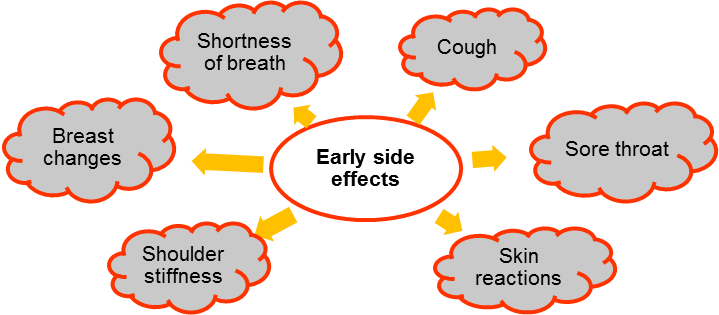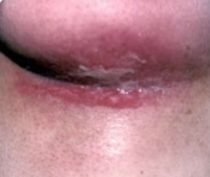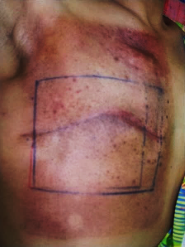
Radiotherapy for chest region may be given to the middle part or one side (left or right) of the chest. Occasionally radiation treatment may be given to both sides (left and right) as in bilateral breast radiotherapy. Normal tissues that may be in the treatment area are skin, part of the throat, esophagus and airway (trachea), lung tissues, breast, and part of the shoulder.
What Are The Early Side Effects?
Early side effects are the changes or reactions of normal tissues that happen during radiation treatment. The symptoms are more serious if there are a lot of normal tissues in the treatment area and if the total radiation dose to the normal tissues is higher. The early effects for chest radiotherapy that may occur are listed in the graphic. Most of the reactions begin in the 2nd to 3rd week of treatment but will get better 3 to 4 weeks after treatment has completed.

Skin Reactions

 The amount and seriousness of skin reactions for chest radiotherapy depend on the type of radiation and the location of treatment area. Treatment using electron beam will produce higher skin dose than photon beam, resulting in greater skin reaction.
The amount and seriousness of skin reactions for chest radiotherapy depend on the type of radiation and the location of treatment area. Treatment using electron beam will produce higher skin dose than photon beam, resulting in greater skin reaction.
Most skin reaction on flat surface (chest wall) are mild (red and dry) and tolerable. However, skinfold areas such as under the breast and armpits can become moist with blisters or ulcers due to dampness and warmth.
Do not wear tight fitting bra, with underwire, which can make the reaction worse. Make sure clothing is loose; keep the area clean and dry. For detailed information on skin reactions and care please refer to Radiotherapy: Skin Reactions & Care.
Sore Throat And Difficult To Swallow
The inner surface of the throat and esophagus may become red, swollen and sore. This may cause uneasiness such as feeling of a lump in the throat and difficulty in swallowing solid food. This reaction is more common for treatment in the upper chest. The effect is worse if the person receives chemotherapy and radiation at the same time, smokes tobacco and drinks alcohol.
These reactions may also affect a person’s appetite, reduce food intake resulting in decreased nourishment and loss of weight. Medication may be given for pain control. However, try making some food adjustment (food choices and preparation) to improve uptake and maintain a balanced diet.
How To Reduce Effects And Improve Food Intake?
|
|
|
Shortness of Breath and Cough
Radiation can cause inflammation of lung tissues (pneumonitis), which produce symptoms of cough, chest tightness and shortness of breath. The symptoms may be worse if chemotherapy and radiotherapy are given at the same time. Normally early symptoms can be relieved with medications.
What Can Be Done To Ease Shortness Of Breath?
|
|
|
Breast Changes
Radiation treatment may produce early breast changes such as soft tissue swelling (lymphedema), tingling sensation and soreness especially at the nipples.
Shoulder Stiffness
Shoulder muscle on the same side of the treatment area may become tense and limit movement of the shoulder joint. Learn some exercises from the physical therapist to relax and strengthen the muscles so that joint mobility can be improved.
Are There Any Late Side Effects?
Late side effects are reactions that may occur months or years after radiation treatment has stopped. Some late effects of chest radiotherapy that may occur are listed in the graphic.

Late effects of lung tissues such as pneumonitis and fibrosis may occur 1 to 6 months after radiation treatment. Symptoms of long term cough, fever, chest tightness and breathlessness can be relieved with medications and breathing exercises.
For breast radiotherapy, the skin in the treatment area will appear slightly darker with red spots (telangiectasia) due to small dilated blood vessels. The treated breast may be slightly smaller because of breast tissue shrinkage.
Surgical procedure for lymphatic removal of the armpit followed by radiation may cause lymphedema to occur to the arm on the same side. Please refer to Arm Or Leg Radiotherapy: Side Effects and Care/ Lymphedema.
Radiotherapy is designed specially for each individual, taking into consideration the radiation effects on normal tissues in the treatment areas. However, every person is unique and may react differently to the radiation treatment.
Find out information about the specific side effects that may occur with your treatment from the radiation oncologist and radiation therapist before treatment begins. Always let them know what you are experiencing and how you feel so that they can help you to minimize the symptoms, to reduce anxiety and to cope better.
References
- http://www.cancer.org/treatment/treatmentsandsideeffects/treatmenttypes/radiation/understandingradiationtherapyaguideforpatientsandfamilies/understanding-radiation-therapy-radiation-to-certain-body-parts
- www.cancer.gov
- Picture from slide presentation of Amanda Bolderston. Standards of skin care in Radiation therapy
- Picture from slide presentation of Aishah S A. Radiotherapy side effects and Patient care
- Graphic from Ms Aisyah Zulkifli
| Last Review | : | 26 May 2017 |
| Writer | : | Sarah Lee Abdullah |
| Accreditor | : | Dr. Ros Suzana binti Ahmad Bustamam |







